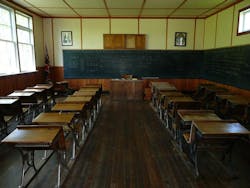Evidence linking classroom design to improved learning mounts
By Peter Fabris, Contributing Editor
A new study backs up the notion that classroom design has a significant impact on the academic performance of primary school children.
Researchers at the University of Salford in the U.K., and architects, Nightingale Associates, found that the classroom environment can affect a child’s academic progress by as much as 25% in a year. The year-long study took place in seven Blackpool, England primary schools in 34 classrooms. The rooms had differing learning environments and several age groups were represented.
Data from 751 pupils included performance level in math, reading, and writing at the start and end of an academic year. Researchers also studied the holistic classroom environment including classroom orientation, natural light and noise, temperature, and air quality. Other factors included flexibility of space, storage facilities and organization, and use of color.
Researchers said the findings suggest that placing an average pupil in the least effective, rather than the most effective classroom environment could affect their learning progress by as much as the average improvement across one year. The study will continue for another 18 months and cover another 20 schools in different areas of the U.K.
